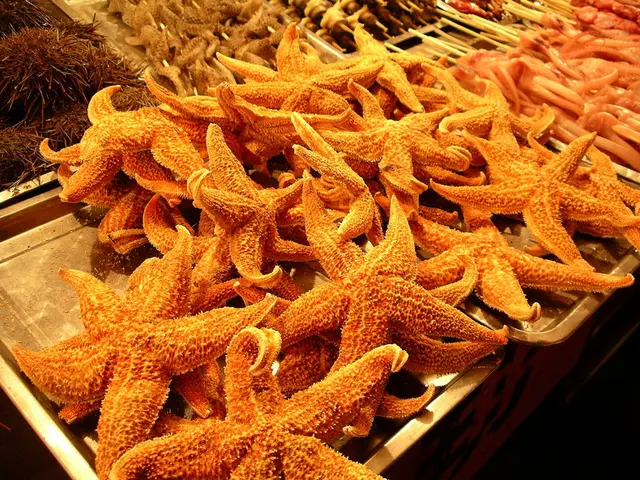16 Methods for Preserving Spring Produce Through Fermentation
Transforming Spring Veggies: Explore the Magic of Fermentation!
Embark on a taste adventure with the springtime delights you've been craving! Ferment these iconic vegetables and more to bring out their unique flavors and maximize their nutritional benefits.
Rediscover the joy of spring classics like radishes, asparagus, and fiddleheads, but don't stop there! The world of spring flavors is vast, and lacto-fermentation allows you to experiment with sprouts, flowers, stems, and even some leaves.
The Pleasure of Spring Veggies Redefined
After the long winter, savor the freshness of spring vegetables with their bursting flavors, vitamins, and essential minerals. However, their harvesting season is short, so let's make the most of them! Here's what lacto-fermentation offers:
- Improved Nutrient Content: Fermented food becomes more digestible, nutrient-rich, and packed with gut-friendly bacteria.
- Extended Harvest Season: Even though some spring veggies have a brief harvesting window, fermentation allows you to enjoy them for longer.
- Amplified Flavors: Spring vegetables already taste great, and lacto-fermentation enhances their flavors, including developing pleasant acidity.
- Wide Variety of Preparations: Lacto-fermentation opens up new culinary possibilities, offering a solution when you're stumped on how to prepare your bounty.
For more insights on the benefits of fermented vegetables, delve into our in-depth article.
Recipes for Fermenting Spring Vegetables
The following recipes serve as a starting point for your fermentation journey. Feel free to explore your favorite herbs and spices for additional flavor!
In search of inspiration? Check out our collection of fermented vegetable recipes.
Ready to dive into fermenting? Review our complete guide on making fermented vegetables.
Asparagus
Spring's star vegetable is best when fresh! To keep asparagus crisp during fermentation, follow these simple tips:
- Choose medium to large asparagus
- Opt for freshly picked asparagus
- Include a source of tannins (grape leaf)
- Keep fermentation brief (1 to 2 weeks)
Pickled Asparagus in Brine
Remove the fibrous ends of the asparagus and cut into sections of equal length. Place in a jar in a 2% brine solution. Add pickle spices (garlic, mustard seed, dill), or a few slices of onion.
White Asparagus With Lemon
Replace green asparagus with white ones for a more delicate taste. Put in a 2% brine solution, with a slice of lemon and a piece of ginger.
Radishes
Radishes are the epitome of spring! Their taste mellows, and the spiciness lessens during fermentation, while keeping the desired crunchiness.
Shredded Fermented Radishes
Weigh and shred the radishes. Massage with 2% salt and put in a jar. Ferment for at least 3 weeks.
Pink Radishes in Brine
Slice the radishes thinly (or cut into quarters) and stack in a jar. Add a few garlic cloves and peppercorns, then cover with a 2% brine solution. Ferment for at least a week. In the brine, the peel colors the entire radish, producing a pretty pink hue!
Radish Kimchi
Rinse and roughly chop radishes and leaves. Coarsely mix in a bowl with Korean chili, ginger, garlic, and salt, then massage to soften the radish stems. Place in a jar and ferment for one to two weeks.
Rhubarb
Yes! You can ferment rhubarb, adding a new depth to its already tangy taste. Rhubarb is delightful in both sweet and savory dishes, such as pickles and chutney. Explore fermented rhubarb in sushi for a surprising twist!
Fermented Rhubarb Pickles
Place rhubarb sticks upright in a jar. Cover with a 2% brine solution, and optionally add a little sugar for a sweet-sour pickle sensation.
Fermented Rhubarb Chutney
Slice the rhubarb and onions, and add cranberries. Put in a jar with 2% salt and ferment for a week. Enjoy on a cream cheese bagel!
Fiddleheads
Fiddleheads are a short-season delight! Take advantage of them by fermenting. Boil the fiddleheads for 15 minutes before preparing, and add raw vegetables or a source of lactic acid bacteria to ensure proper fermentation.
Fermented Fiddleheads
Boil the fiddleheads for 15 minutes, discard the water, and allow them to cool. Stack in a jar with shredded cabbage, garlic, and a grape leaf (lactic acid bacteria source is optional but recommended). Cover with a 2% brine solution and ferment for 3 to 4 weeks.
Enjoy your fermented spring vegetables with our Fermentation Revolution book recommendation.
Ramps (wild garlic)
Ramps' leaves offer a delicate taste, while their bulb has a milder flavor than regular garlic. However, fermented ramps display a strong, mouthwatering aroma.
Caution: This is a vulnerable species in Quebec. Ferment ramps responsibly and sustainably if possible.
Fermented Ramps Pesto
Coarsely chop the wild garlic and squeeze firmly into a jar. Mix with your favorite spring herbs (arugula, nettle, sage, etc.), cover with a 2% brine solution, and let ferment for at least a week. Puree and serve as a pesto.
Wild Garlic Bulbs in Brine
Stack the bulbs in a jar and cover with a 2% brine solution. Ferment for a few weeks.
Wild Garlic Kimchi Recipe
Wild garlic leaves are perfect for kimchi! Substitute cabbage with wild garlic leaves in your preferred kimchi recipe, or instead, replace the onion, green onion, or garlic.
Flower Buds (Dandelion, Daisy, Chives, etc.)
Discover the versatility of flower buds and make your own local capers! Harvest the buds while they are immature, green, and in buds.
Daisy Bud Capers in Brine
Pick the daisy buds while they are still green, remove the small leaves at the base, rinse, and put in a jar before covering with a 3% brine solution. Ferment for at least 2 weeks.
Chive Flower Kimchi
Add chive flowers to your kimchi recipe to replace onion, green onion, or garlic and let ferment for a few days.
Grape Leaves (vine leaves)
Grape leaves can be enjoyed all year round, but their texture improves when fermented. Harvest end-May to early June for tender leaves. Make delightful dolmas, Greek-style stuffed grape leaves, or use the tannins in the grape leaves to keep pickles crunchy during the pickling season.
Grape Leaves Recipe for Dolmas
Roll and stack grape leaves in a jar with garlic cloves and dill, cover with a 4% brine solution, and let ferment for 2 to 3 weeks.
Spruce Tips
Don't ignore the potential of spruce tips! Picked in the spring, they offer a strong resinous taste with a slight bitterness and lemony notes. Use them in traditional spruce beer or incorporate them into lacto-fermentation for unique flavor.
Fermented Spruce Tips
Remove the resinous caps from the spruce tips, rinse, and put in a jar with a 2% brine. Ferment for at least one week.
Spruce Tips Sauerkraut
Add a few sprouts to your favorite sauerkraut recipe to craft a cabbage dish with a northern spin!
Get the Tools!
Stock up on essential lactofermentation tools and equipment to elevate your fermentation game.
Get Started!
- Complete Guide to Lacto-Fermentation
- Lacto-fermentation materials and equipment
- Canning vs Fermentation: what to choose?
- Recipe ideas for fermenting
- Summer vegetables
- Winter vegetables
- Fall vegetables
- Expand your culinary repertoire by trying out various fermented vegetable recipes using spring veggies like radishes, asparagus, and rhubarb.
- For a unique take on fitness and wellness, incorporate fermented radishes, spring onions, and dandelion buds into your healthy-cooking routine, adding a burst of flavors and nutrients to your meals.
- Embrace a complete lifestyle shift by incorporating lacto-fermented fruits and vegetables like spruce tips and grape leaves in your food-and-drink choices, enhancing their flavors and maximizing health benefits.







